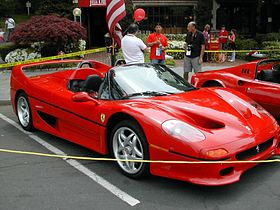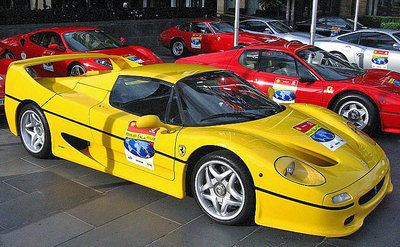Ferrari F50

| |
| Ferrari F50 | |
|---|---|
| Manufacturer: | Ferrari |
| Class: | mid-engined coupe |
| Production: | 1996 — 1997 |
| Predecessor: | Ferrari F40 |
| Related: | Ferrari F50 GT |
| Successor: | Ferrari Enzo Ferrari |
| Body Styles: | Berlinetta |
| Engines: | 4.7 L V12 |
The Ferrari F50 was a mid-engine sports car made by Ferrari. The F50 was introduced in 1995 to celebrate the company's 50th anniversary. The car is a two door, two seat convertible with a removable hardtop. It has a 4.7 L naturally-aspirated 60-valve V12 engine that was developed from the 3.5L V12 used in the 1992 Ferrari F92 Formula One car.
Only 349 cars were made, one fewer than Ferrari estimated they could sell. This was, in the words of Ferrari spokesman Antonio Ghini, because "Ferraris are something cultural, a monument. They must be hard to find, so we will produce one less car than the market." The last F50 was produced in Maranello, Italy in July 1997.
The F50's engine predated the car: It was used in the Ferrari 333 SP for the American IMSA series in 1994 allowing it to become eligible for the stock engine WSC category.
Racing
Main data Ferrari F50 GT
Following the motorsports theme Ferrari developed the F50 GT, a prototype based on the F50 that was built to compete in GT1-class racing. The car had a fixed roof, large rear spoiler, new front spoiler and many other adjustments. The 4.7 litre V12 engine was tuned to generate around 750bhp. In testing in 1996 the car proved to be quicker even than the 333SP, but this went unnoticed as Ferrari cancelled the F50 GT project, instead focusing on Formula 1. Ferrari sold off the three complete chassis that were built - the test car 001, 002 and 003. Chassis 002 and 003 had bodies fitted before being sold. The remaining three tubs were apparently destroyed.
A custom made F50 variant named the Bolide was commissioned by the Sultan of Brunei in 1998 and delivered in the same year. It used the F1 derived V12 engine and the same chassis, but was completely redesigned due to the monocoque construction of the body on the F50. One car was produced in the coupe configuration. Very few images and no official performance statistics of the car are available.
Specifications
General
Price (1995): $480,000-$555,000
Manufactured in: Maranello, Italy
Number Produced: 349 (1995 to July 1997)
Inspiration: Alain Prost's 1990 Ferrari 641/2 F1 racecar
Dimensions
Weight: 2976 lb.
Distribution: 42%/58% (front/rear)
Length: 176.4 in.
Height: 44.1 in.
Width: 78.2 in.
Wheelbase: 101.6 in.
Front track: 63.8 in.
Rear track: 63.1 in.
Engine
Name: Tipo F130, model SFE 4.7 VJGAEA
Position: Mid-Engine
Configuration: Longitudinal 60-valve 65° V12, derived from F1 unit
Aspiration: Natural, with Variable Length Intake Manifold via butterfly valve in Intake Manifold
Intake Manifold: Carbon Fiber
Block: Nodular cast iron
Heads/Pistons: Light-alloy aluminum heads/forged Mahle pistons
Oil Sump: Aluminium
Connecting Rods: Forged titanium
Crankshaft: Forged steel
Cam covers/Oil and Water pump housing: Magnesium sand castings
Exhaust Manifold: Stainless steel
Weight: 436.5 lb
Timing gear: 5 valve/cyl (3 intake, 2 exhaust), 4 overhead camshafts (2 per cylinder bank) driven by low-noise Morse chain
Displacement: 4698 cc/286.68ci
Max Power: 513bhp @ 8000 rpm
Max Torque: 347ft.lbf @ 6500 rpm
Power/Disp.: 109.1 bhp/litre
Weight/Power: 5.8 lb/bhp
Bore x Stroke: 3.35 in. x 2.72 in.
Bore:Stroke: 1.23:1 (Oversquare)
Compression: 11.3:1
Redline: 8500 rpm
ECU: Bosch Motronic 2.7 (controls the fuel feed, ignition timing, and variable length intake and exhaust systems)
Fuel Feed: Sequential injection
Ignition: Bosch Static electronic distributorless ignition
Lubrication: Dry Sump, tank incorporated within the final drive housing, 3 scavenger pumps
Variable Intake: Butterfly valve in carbon fiber intake manifold closed at low rpm, open at high rpm
Variable Exhaust: Butterfly valve in upper tailpipes closed at low rpm, open at high rpm
Fuel Tank: Foam filled, aeronautical-style Sekur rubber bladder, 27.7 US gal.
Transmission
Configuration: Longitudinal 6 Speed Manual + Reverse, Limited Slip Differential, RWD
Gear ratios: 2.933:1 (1st), 2.157:1 (2nd), 1.681:1 (3rd), 1.360:1 (4th), 1.107:1 (5th), 0.903:1 (6th), 2.529:1 (Reverse)
Final drive: 3.70:1
Flywheel: Steel
Final Drive Assembly: Aluminum sand casting
Remaining gearset housing: Magnesium sand casting
Support bracing: Steel
Clutch: Dry, twin plate
Cooling: Oil-water intercooler between gearbox lubricant and engine
Chassis
Type: Central carbon fiber tub, light-alloy suspension and engine-gearbox assembly mounting points co-polymerised to the chassis
Materials: Carbon fiber, epoxy resin, Nomex honeycomb core, sandwich construction
Weight: 2249 lb
Torsional stiffness: 25500 ft.lbf per degree
Suspension
Front: F1-derived, rose-jointed unequal-length wishbones, push-rods, coil springs, Bilstein gas-pressurised monotube dampers, electronic adaptive damping, electronic height adjustment (40 mm max)
Rear: F1-derived, rose-jointed unequal-length wishbones, push-rods, coil springs, Bilstein gas-pressurised monotube dampers, electronic adaptive damping, mounting points on a spacer between the engine and gearbox
Travel: 55 mm bump, 60 mm rebound
Camber: -0.7 degrees front, -1.0 degrees rear
Anti-Roll bars: Front and rear
Max roll angle: 1.5 degrees
Steering
Type: TRW rack and pinion, 3.3 turns lock to lock, unassisted
Castor: 5.5 to 5.7 degrees
Turning Circle: 41ft
Electronic Adaptive Damping (Based on steering wheel angle and velocity, the body’s vertical and longitudinal acceleration, brake line pressure, and vehicle speed.)
Maximum reaction time (from minimum to maximum damping force or vice versa): 140 milliseconds (0.14 sec).
Average reaction time (from minimum to maximum damping force or vice versa): 25 to 30 milliseconds (.025 to .03 sec)
Wheels/Tires/Brakes
Wheels: Magnesium alloy, manufactured by Speedline
Hubs: Titanium
Brake disc bells/suspension uprights/brake calipers: Aluminum
Upper and lower wishbones: Black powder-coated steel
Front Wheels: 18 in. x 8.5 in.
Front Tires: 245/35ZR-18 Goodyear Eagle F1 GS Fiorano (35psi)
Front Brakes: 14.0 in. Brembo Cross-drilled & ventilated cast iron discs, 4 piston aluminum Brembo calipers, Pagid brake pads, unassisted
Rear Wheels: 18 in. x 13 in.
Rear Tires: 335/30ZR-18 Goodyear Eagle F1 GS Fiorano (30psi)
Rear Brakes: 13.2 in. Brembo Cross-drilled & ventilated cast iron discs, 4 piston aluminum Brembo calipers, Pagid brake pads, unassisted
Unsprung Mass: 99 lb/121 lb (front corners/rear corners)
Color Popularity
Rosso Corsa (Red) : 302
Giallo Modena (Yellow) : 31
Rosso Barchetta (Dark red) : 8
Argento Nurburgring (Silver) : 4
Nero Daytona (Black) : 4
Performance
0-60 mph: 3.7 sec
0-100 mph: 6.5 sec
0-1000 m: 21.7 sec
0-1 mile: 30.3 sec
60-0 mph: 118ft.
1/4 Mile: 11.1 @ 123.0 mph
Top Speed: 202mph
Downforce: 970 lb @ 202mph, 40%/60% (front/rear)
Cd: 0.372
Skidpad: 1.03g
Slalom: 71.8 mph
MPG: 8/11 mpg (cty/hwy) (Factory numbers: 8.4/14.1 mpg)
1995 Ferrari F50 (US Model)
- 1995 Ferrari F50 (US Model) 1.jpg
- 1995 Ferrari F50 (US Model) 2.jpg
- 1995 Ferrari F50 (US Model) 3.jpg
- 1995 Ferrari F50 (US Model) 4.jpg
- 1995 Ferrari F50 (US Model) 6.jpg
- 1995 Ferrari F50 (US Model) 7.jpg
- 1995 Ferrari F50 (US Model) 8.jpg
- 1995 Ferrari F50 (US Model) 10.jpg
- 1995 Ferrari F50 (US Model) 11.jpg
- 1995 Ferrari F50 (US Model) 12.jpg
| < Ferrari timeline 1948–1967 | Ferrari timeline 1960s-1990s | Ferrari timeline 1990–Present > | |||||||||||||||||||||||||||||||||||||||
| Type | 1960s | 1970s | 1980s | 1990s | |||||||||||||||||||||||||||||||||||||
| 0 | 1 | 2 | 3 | 4 | 5 | 6 | 7 | 8 | 9 | 0 | 1 | 2 | 3 | 4 | 5 | 6 | 7 | 8 | 9 | 0 | 1 | 2 | 3 | 4 | 5 | 6 | 7 | 8 | 9 | 0 | 1 | 2 | 3 | 4 | 5 | 6 | 7 | 8 | 9 | ||
| 8 cylinder | Mid-engine berlinetta | 308 | 308 i | 308 QV | 328 | 348 | 360 | ||||||||||||||||||||||||||||||||||
| 208 | 208 Turbo | GTB/GTS Turbo | F355 | ||||||||||||||||||||||||||||||||||||||
| Mid-engine 2+2 | 308 GT4 | Mondial 8 | Mondial QV | Mondial 3.2 | Mondial t | ||||||||||||||||||||||||||||||||||||
| 208 GT4 | |||||||||||||||||||||||||||||||||||||||||
| 12 cylinder | Boxer berlinetta | 365 BB | 512 BB | 512i BB | Testarossa | 512TR | F512M | ||||||||||||||||||||||||||||||||||
| Grand tourer | 250 | 275 | 365 GTB/4 "Daytona" |
550 Maranello | |||||||||||||||||||||||||||||||||||||
| America | 330 | 365 | |||||||||||||||||||||||||||||||||||||||
| 2+2 coupé | 250 GT/E | 330 GT 2+2 | 365 GT 2+2 | 365GTC/4 | GT4 2+2 | 400 | 400 i | 412 | 456 | 456 M | |||||||||||||||||||||||||||||||
| Supercar | 250 GTO | 250 LM | 288 GTO |
F40 | F50 | ||||||||||||||||||||||||||||||||||||
| Sold under the Dino marque until 1976; see also Ferrari Dino | |||||||||||||||||||||||||||||||||||||||||

